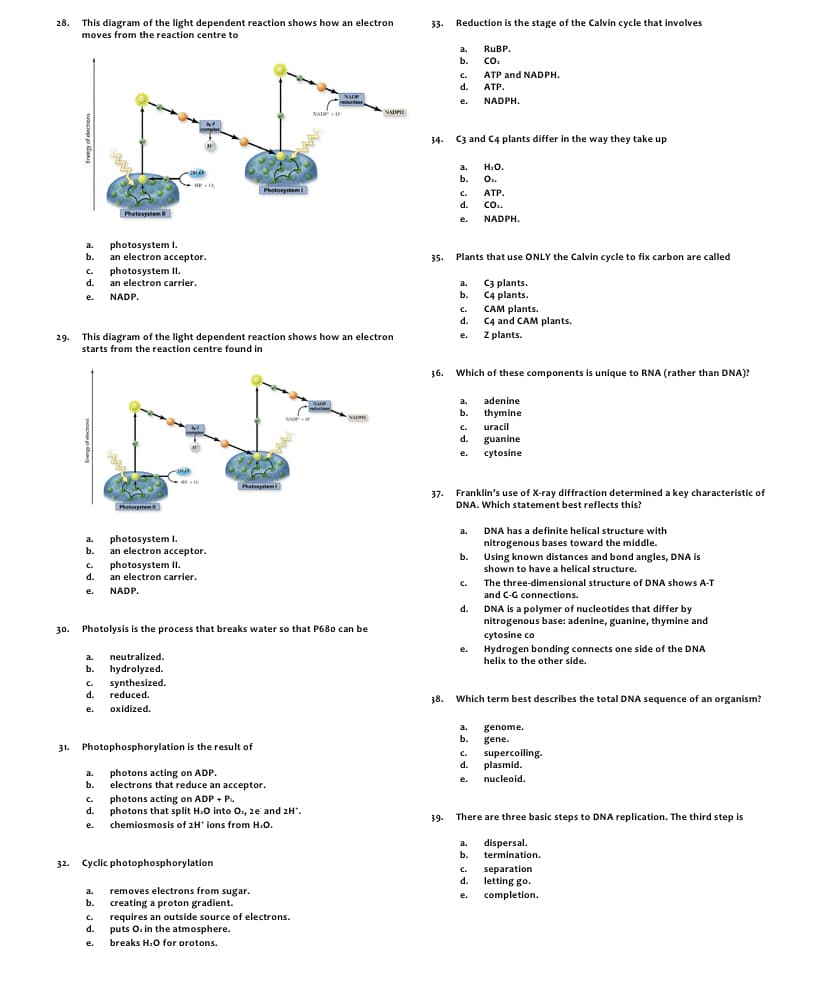28. This diagram of the light dependent reaction shows how an electron moves from the reaction centre to Photneystem Phetesptem photosystem I. an electron acceptor. photosystem II. a. b. C. d. an electron carrier. e. NADP. 29. This diagram of the light dependent reaction shows how an electron starts from the reaction centre found in Phetergtem photosystem I. an electron acceptor. a. b. . photosystem II. d. an electron carrier. e. NADP. 30. Photolysis is the process that breaks water so that P680 can be a. neutralized. b. hydrolyzed. C. synthesized. d. reduced. e. oxidized. Energfelectom Eneegy of electens
28. This diagram of the light dependent reaction shows how an electron moves from the reaction centre to Photneystem Phetesptem photosystem I. an electron acceptor. photosystem II. a. b. C. d. an electron carrier. e. NADP. 29. This diagram of the light dependent reaction shows how an electron starts from the reaction centre found in Phetergtem photosystem I. an electron acceptor. a. b. . photosystem II. d. an electron carrier. e. NADP. 30. Photolysis is the process that breaks water so that P680 can be a. neutralized. b. hydrolyzed. C. synthesized. d. reduced. e. oxidized. Energfelectom Eneegy of electens
Biology (MindTap Course List)
11th Edition
ISBN:9781337392938
Author:Eldra Solomon, Charles Martin, Diana W. Martin, Linda R. Berg
Publisher:Eldra Solomon, Charles Martin, Diana W. Martin, Linda R. Berg
Chapter9: Photosynthesis: Capturing Light Energy
Section: Chapter Questions
Problem 4TYU: In ________, electrons that have been energized by light contribute their energy to add phosphate to...
Related questions
Question

Transcribed Image Text:This diagram of the light dependent reaction shows how an electron
moves from the reaction centre to
28.
33.
Reduction is the stage of the Calvin cycle that involves
a.
RUBP.
b.
Co:
C.
d.
ATP and NADPH.
АТР.
NAUP
ouctase
NADPH.
е.
NAI
NADPIE
C3 and C4 plants differ in the way they take up
34-
a.
H.O.
b.
O.
Photosystem
ATP.
C.
d.
Co.
Photorystem
e.
NADPH.
photosystem I.
an electron acceptor.
photosystem II.
an electron carrier.
a.
b.
35.
Plants that use ONLY the Calvin cycle to fix carbon are called
c.
C3 plants.
C4 plants.
d.
a.
NADP.
b.
e.
CAM plants.
C.
d.
C4 and CAM plants.
Z plants.
This diagram of the light dependent reaction shows how an electron
e.
е.
29.
starts from the reaction centre found in
36.
Which of these components is unique to RNA (rather than DNA)?
a.
adenine
N
b.
thymine
C.
uracil
d.
guanine
cytosine
е.
Pheteystem
37
Franklin's use of X-ray diffraction determined a key characteristic of
Photorytem
DNA. Which statement best reflects this?
a.
DNA has a definite helical structure with
photosystem I.
an electron acceptor.
a.
nitrogenous bases toward the middle
Using known distances and bond angles, DNA is
shown to have a helical structure.
b.
b.
photosystem II
c.
d.
an electron carrier.
The three-dimensional structure of DNA shows A-T
and C-G connections.
C.
e.
NADP.
DNA is a polymer of nucleotides that differ by
nitrogenous base: adenine, guanine, thymine and
d.
30. Photolysis is the process that breaks water so that P680 can be
cytosine co
Hydrogen bonding connects one side of the DNA
helix to the other side.
e.
a.
neutralized.
hydrolyzed.
synthesized.
reduced.
b.
c.
d.
38.
Which term best describes the total DNA sequence of an organism?
e.
oxidized.
genome.
gene.
a.
b.
31.
Photophosphorylation is the result of
C.
supercoiling.
d.
plasmid.
photons acting on ADP.
electrons that reduce an acceptor.
a.
e.
nucleoid.
b.
C.
d.
photons acting on ADP + P.
photons that split H:0 into 0:, 2e and 2H".
39.
There are three basic steps to DNA replication. The third step is
chemiosmosis of 2H' ions from H.O.
e.
dispersal.
a.
b.
termination.
32. Cyclic photophosphorylation
c.
separation
d.
letting go.
removes electrons from sugar.
creating a proton gradient.
requires an outside source of electrons.
puts O. in the atmosphere.
a.
completion.
е.
b.
c.
d.
e.
breaks H.O for protons.
Expert Solution
This question has been solved!
Explore an expertly crafted, step-by-step solution for a thorough understanding of key concepts.
This is a popular solution!
Trending now
This is a popular solution!
Step by step
Solved in 2 steps

Knowledge Booster
Learn more about
Need a deep-dive on the concept behind this application? Look no further. Learn more about this topic, biology and related others by exploring similar questions and additional content below.Recommended textbooks for you

Biology (MindTap Course List)
Biology
ISBN:
9781337392938
Author:
Eldra Solomon, Charles Martin, Diana W. Martin, Linda R. Berg
Publisher:
Cengage Learning


Concepts of Biology
Biology
ISBN:
9781938168116
Author:
Samantha Fowler, Rebecca Roush, James Wise
Publisher:
OpenStax College

Biology (MindTap Course List)
Biology
ISBN:
9781337392938
Author:
Eldra Solomon, Charles Martin, Diana W. Martin, Linda R. Berg
Publisher:
Cengage Learning


Concepts of Biology
Biology
ISBN:
9781938168116
Author:
Samantha Fowler, Rebecca Roush, James Wise
Publisher:
OpenStax College